
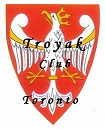
8th March 2020 …
XVII Polish – Canadian Coin, Stamp & Collectibles Show 2020
Sunday 8th March 2020 from 9:00 a.m. to 4 p.m.
@
John Paul II Polish Cultural Centre
4300 Cawthra Rd. (just south of Hwy. 403)
Mississauga, Ontario. L4Z 1V8
60 Tables & over 30 Dealers, Free evaluations Canadian &
World Coins, Stamps, Paper money, Silver & Gold bullion, Supplies.
Free parking, Adult admission $ 5.00.
Dealer contact: Les Plonka 416-505-7999 or leszekp@rogers.com
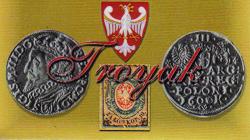
TROYAK EXECUTIVE TEAM is informing all members, colleagues, collectors and Polonia at large, that Club meetings taking place at John Paul II Polish Cultural Centre, 4300 Cawthra Rd. (just south of Hwy. 403), Mississauga, Ontario. The new members are always welcome. www.polishculturalcentre.ca
ADRES SPOTKAÑ KLUBOWYCH ! Zarząd Główny Klubu “Troyak” informuje wszystkich członków kolekcjonerów, sympatyków oraz całą Polonię, że spotkania klubowe odbywają się w Polskim Centrum Kultury im. Jana Pawła II, przy 4300 Cawthra Rd. (na południe od autostrady 403), Mississauga, Ontario. Zapraszamy nowych członków do prężnego. Klubu “Troyak”. www.polishculturalcentre.ca

“TROYAK” CLUB NEXT MEETINGS …
NASTĘPNE SPOTKANIA KLUBU “TROYAK” …
29th March 2020 @ 4:30 p.m.
26th April 2020
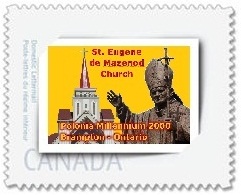
TROYAK CLUB @ St. John Paul II – 100
Birthday Anniversary Celebration 2020
Sunday 10 May 2020
9:00 a.m. to 4 p.m.
@
Our Lady Queen Of Poland Parish
Parafia Matki Bożej Królowej Polski
625 Middlefield Rd, Scarborough, ON M1V 5B8
Displays of Coins, Medals, Stamps, Collectibles dedicated to
St. John Paul II by Troyak Club Members.

TROYAK CLUB @ St. John Paul II – 100
Birthday Anniversary Celebration 2020
Saturday 16 May 2020 … 12:00 p.m. to 8:00 p.m.
Sunday 17 May 2020 … 9:00 a.m. to 8:00 p.m.
St. Casimir’s Church
www.kazimierz.org
Parish Hall … 156 Roncesvalles Ave. Toronto, ON M6R 2L4
Stamp Exhibit … Pope John Paul II on World Stamps and
displays of Coins, Medals, Collectibles dedicated to
St. John Paul II by Troyak Club Members.

TROYAK CLUB @ St. John Paul II – 100
Birthday Anniversary Celebration 2020
Sunday 24 May 2020
9:00 a.m. to 4 p.m.
@
John Paul II Polish Cultural Centre,
4300 Cawthra Rd. Mississauga, ON L4Z 1V8
Displays of Coins, Medals, Stamps, Collectibles dedicated to
St. John Paul II by Troyak Club Members.

TROYAK CLUB @ St. John Paul II – 100
Birthday Anniversary Celebration 2020
Sunday 31 May 2020
9:00 a.m. to 4 p.m.
@
Our Lady of Perpetual Help Catholic Church
Kosciół Matki Boskiej Nieustającej Pomocy
5 Oblate St. St. Catharines, ON L2M 5C5
Displays of Coins, Medals, Stamps, Collectibles dedicated to
St. John Paul II by Troyak Club Members.

31st May 2020
28th June 2020

July & August 2020 – Summer break … Letnie wakacje …

TROYAK CLUB @ Roncesvalles Polish Festival 2020
Saturday, September 12th … Sunday, September 13th, 2020
https://polishfestival.ca www.kazimierz.org

27th September 2020

4th October 2020 @ 9:00 a.m. to 4:00 p.m. …
Mississauga’s 5th Annual Fall Show
25th October 2020; 29th November 2020

Sztuka europejska w zbiorach polskich
European art in Polish collections
www.poczta-polska.pl
Dnia 28 października 2019 r. został wprowadzony do obiegu znaczek pocztowy o wartości 6,00 zł emisji “Sztuka europejska w zbiorach polskich”. Na znaczku przedstawiony został obraz Kazanie św. Jana Chrzciciela, autorstwa Pietera Brueghela młodszego, ze zbiorów Muzeum Narodowego w Krakowie. Znaczek wydrukowano techniką offsetową, na papierze fluorescencyjnym, w formacie: 51 x 39,5 mm, w nakładzie 100 000 sztuk. Arkusz zawiera 5 szt. znaczków i pustopole. Z tej okazji została wydana również koperta FDC. Autor projektu znaczka: Maciej Jędrysik.
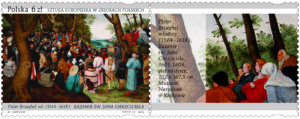
European art in Polish collections … denomination: 6,00 PLN;
number of stamps in set: 1; print run: 100.000 pcs.; paper: fluorescent;
printing techniques: offset; stamp size: 51 x 39,5 mm;
5 stamps in sheet; number of FDC: 1; author: Maciej Jędrysik;
circulation date: 28th October 2019.

Światowa Konferencja Antydopingowa 2019
World conference on doping in sport 2019
www.poczta-polska.pl
Dnia 05 listopada 2019 r. została wprowadzona do obiegu kartka pocztowa z nadrukowanym znakiem opłaty pocztowej, emisji: Światowa Konferencja Antydopingowa 2019. Wartość nominalna znaku opłaty pocztowej z oznaczeniem literowym A odpowiada wartości nominalnej znaczka pocztowego używanego do uiszczenia opłaty za ekonomiczną przesyłkę listową nierejestrowaną, w tym kartkę pocztową, w obrocie krajowym, w formacie S o masie do 500 g.
W prawym górnym rogu strony adresowej kartki nadrukowano znak opłaty pocztowej, na którym umieszczono napis: Światowa Konferencja Antydopingowa 2019; wzdłuż dolnej, prawej krawędzi znaczka umieszczono napis: POLSKA oraz oznaczenie wartości: A. W części ilustracyjnej kartki znajduje się: 1) ilustracja przedstawiająca fragment tylnej części roweru wraz z przerwanym łańcuchem, którego zerwane ogniwa stanowią kapsułki symbolizujące doping w sporcie, 2) logo konferencji wzdłuż dolnej krawędzi kartki. Kartkę o wymiarach 148 x 105 mm, wydrukowano jednostronnie, techniką offsetową, na kartonie białym, w nakładzie 8000 sztuk. Autor projektu kartki: J. Konarzewski.
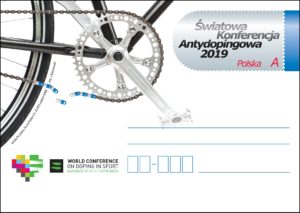
World conference on doping in sport 2019 … denomination: 3,30 PLN;
number of stationeries in set: 1; print run: 8.000 pcs;
printing technique: offset; card size: 148 x 105 mm;
author: J. Konarzewski; release date: 05th November 2019.

Chińskie znaki zodiaku
Chinese Zodiac signs
www.poczta-polska.pl
W dniu 27 stycznia 2020 roku został wprowadzony do obiegu znaczek pocztowy o wartości 3,30zł emisji “Chińskie znaki zodiaku”. Na znaczku widnieje grafika przedstawiająca szczura; wzdłuż dolnej krawędzi znaczka umieszczono napis: Rok Szczura Chińskie znaki zodiaku, a wzdłuż górnej krawędzi – oznaczenie wartości: 3,30 zł i napis: POLSKA. Znaczki wydrukowano techniką offsetową, na papierze fluorescencyjnym, w formacie 45 x 45 mm, w tym koło o średnicy 40 mm, w nakładzie 168 000 sztuk. Arkusz sprzedażny zawiera 8 sztuk znaczków. Z tej okazji została wydana koperta FDC. Autor projektu: Andrzej Gosik.
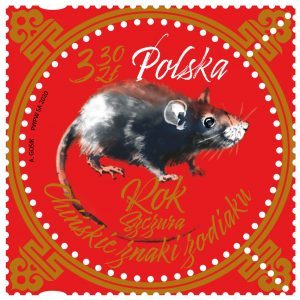
Chinese Zodiac signs … denomination: 3,30 PLN;
number of stamps in set: 1; print run: 168.000 pcs;
printing technique: offset; number of FDC: 1;
stamp size: 45 x 45 mm, 40 mm diameter circle
author: Andrzej Gosik; circulation date: 27th January 2020.

100-lecie polskiego lotnictwa wojskowego
www.nbp.pl
Narodowy Bank Polski jest centralnym bankiem państwa odpowiadającym za politykę pieniężną i stabilność cen. Jego funkcje określa Konstytucja Rzeczypospolitej Polskiej i ustawa o NBP. NBP ma wyłączne prawo emisji pieniądza. Jako bank centralny nie prowadzi rachunków bankowych obywateli, nie przyjmuje od nich lokat, nie udziela kredytów. Prowadzi natomiast obsługę budżetu państwa, a także podmiotów sektora finansów publicznych. Gromadzi rezerwy walutowe państwa i zarządza nimi. Pełni funkcję banku banków, tworząc warunki do działania systemu bankowego. Jest również jednym z najważniejszych ośrodków naukowo-analitycznych w dziedzinie ekonomii i rynków finansowych. 12 grudnia 2019 roku Narodowy Bank Polski wprowadził do obiegu srebrną monetę o nominale 10 zł „100-lecie polskiego lotnictwa wojskowego”.
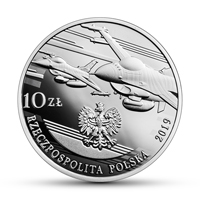
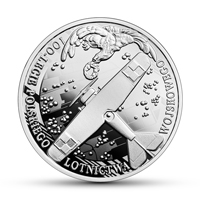
Nominał 10 zł … metal: Ag 925/1000; stempel: lustrzany;
średnica: 32,00 mm; masa: 14,14 g; brzeg (bok): gładki;
nakład: do 15 000 szt.; Projektant: Robert Kotowicz; Emitent: NBP;
Na zlecenie NBP monety wyprodukowała Mennica Polska S.A.
Gdy po zakończeniu I wojny światowej w 1918 r., po 123 latach rozbiorów odradzało się niepodległe państwo polskie, a wraz z nim jego siły zbrojne, zaczęto także tworzyć polskie lotnictwo wojskowe. Klęska poniesiona przez zaborców na frontach Wielkiej Wojny osłabiła ich panowanie na terenach polskich. Dzięki temu Polacy zdołali opanować wiele ważnych lotnisk, na których zdobyto pewną ilość sprzętu latającego. Okazało się też, że w powstającym wojsku są ludzie z przeszkoleniem lotniczym uzyskanym w armiach zaborczych. Od pierwszych dni swego istnienia polskie lotnictwo włączyło się w walkę o utrzymanie odzyskanej niepodległości. Przyjmuje się, że pierwszy lot bojowy został wykonany już 5 listopada 1918 r. przez por. pil. Stefana Bastyra i obserwatora por. Janusza de Beaurain, którzy z powodzeniem zaatakowali z powietrza oddziały ukraińskie podczas walk we Lwowie. Po tym pierwszym locie nastąpiły kolejne. Wielu lotników tego pionierskiego okresu zapisało się w historii. Był wśród nich por. pil. Stefan Stec, którego uznaje się za twórcę znaku biało-czerwonej szachownicy. Dnia 1 grudnia 1918 r. rozkazem nr 38 szefa Sztabu Generalnego WP została ona zatwierdzona jako znak rozpoznawczy polskiego lotnictwa wojskowego.
Polskie lotnictwo broniło ofiarnie i skutecznie dopiero co odzyskanej niepodległości w wojnie polsko-ukraińskiej (1918−1919) i polsko-bolszewickiej (1919−1921). W okresie międzywojennym podjęto godne uznania wysiłki, by rozwijać lotnictwo wojskowe, jednak we wrześniu 1939 r. musiało ono ulec przewadze niemieckiej Luftwaffe. Mimo poniesionej wówczas porażki polscy lotnicy zapisali chlubne karty w historii II wojny światowej. Walczyli nad Francją, Wielką Brytanią, w bitwie o Atlantyk, nad Afryką i w bombowej ofensywie nad Niemcami aż do zakończenia wojny w maju 1945 r. Po wojnie polskie lotnictwo walczące na Zachodzie zostało rozwiązane w 1946 r., a to działające na Wschodzie u boku ZSRR stało się zalążkiem (ludowego) lotnictwa polskiego wchodzącego w skład sił powietrznych państw Układu Warszawskiego (1955−1991).
Po upadku systemu komunistycznego i demokratycznych przemianach lat 1989−1991 lotnictwo wojskowe Rzeczypospolitej Polskiej, będącej od 1999 r. członkiem NATO, przechodzi obecnie proces modernizacji. Jest wyposażane w nowoczesny sprzęt latający. Rewers monety nawiązuje do początków polskiego lotnictwa wojskowego. Pokazano na nim sylwetkę samolotu myśliwskiego Fokker E.V (D.VIII), na jakim latali polscy piloci w walkach przeciwko Ukraińcom o Lwów i na froncie południowym w 1918 r. Samolot ma na skrzydłach duże biało-czerwone szachownice – znak rozpoznawczy polskiego lotnictwa wojskowego przyjęty w 1918 r. Nad nim umieszczono zaprojektowaną przez prof. Władysława Gruberskiego i wprowadzoną w 1919 r. odznakę pilota wojskowego, tzw. gapę, przedstawiającą orła z rozpostartymi w locie skrzydłami, trzymającego w dziobie wieniec laurowy. Całość umieszczona jest na tle widocznej z lotu ptaka siatki pól, charakterystycznej dla polskiego krajobrazu. Na awersie monety, nawiązującym do współczesnego polskiego lotnictwa wojskowego, przedstawiono sylwetki dwóch samolotów F-16 w locie. Informacja: Wojciech Krajewski konsultant merytoryczny Muzeum Wojska Polskiego.

100th Anniversary of Polish Military Aviation
www.nbp.pl
Narodowy Bank Polski is the central bank of the State, responsible for its monetary policy and price stability. The Bank’s functions are described in the Constitution of the Republic of Poland and the Act on NBP. NBP holds the exclusive right to issue the currency of the Republic of Poland. As the central bank, it does not provide accounts for the general public, accept deposits from or extend loans to individuals. It acts as a banker to the State budget and public sector entities. NBP also holds and manages the foreign exchange reserves of the State. Finally, it functions as a banker to banks, creating conditions for the operation of the Polish banking system. Narodowy Bank Polski is one of the most important research and analytical centres in the fields of economics and financial markets. On 12 December 2019, Narodowy Bank Polski issued into circulation a silver coin “100th Anniversary of Polish Military Aviation”, with a face value of 10 złoty.


Face value: 10 zł … Metal: Ag 925/1000; Finish: proof;
Diameter: 32.00 mm; Weight: 14.14 g; Edge (side): plain;
Mintage: up to 15,000 pcs; Designer: Robert Kotowicz; Issuer: NBP;
The coins, commissioned by NBP, were struck by Mennica Polska S.A.
When World War I ended in 1918, the independent Polish state was re-emerging following 123 years of partitions. This development was accompanied by the formation of national armed forces and military aviation. The defeat of the Austrian and German empires on the fronts of the Great War weakened their control over the Polish territory. This enabled the Poles to take over a number of major enemy airfields, where they captured a certain number of aircraft. Moreover, the emerging air force included airmen who had received pilot and observer training in the Austrian and German air forces. Since its very beginning, the Polish air force joined in the fight to keep the newly regained independence. It is assumed that the first combat flight was already carried out on 5 November 1918 by a crew of pilot F/O Stefan Bastyr and air observer F/O Janusz de Beaurain, who conducted a successful bombing of Ukrainian troops during the Lviv fighting. After the first flight, more flights followed. In these pioneering days, many Polish airmen passed into history. One of them was F/O Stefan Stec, who is regarded as the designer of the white-and-red chequerboard sign. On 1 December 1918, it was approved as the national marking of all Polish military aircraft by order no. 38 of the chief of the General Staff of the Polish Army.
The Polish air force defended the freshly regained independence devotedly and effectively during the Polish-Ukrainian war (1918−1919) and the Polish-Bolshevik war (1919−1921). In the interwar period, it made admirable efforts to develop military aviation. Nevertheless, in September 1939 it had to yield to the air superiority of the German Luftwaffe. Despite their defeat, the Polish airmen had written some glorious chapters in the history of World War II. They had fought over France and Great Britain, in the Battle of the Atlantic, over Africa and in the bombing of Germany, until the end of the war in May 1945. After the war, the Polish air force fighting in the West was disbanded in 1946, while that operating in the East on the Soviet side became the source of the Air Force of the Polish People’s Republic forming part of the air forces of the member states of the Warsaw Pact (1955−1991). After the fall of the communist regime and the democratic transformations in the years 1989−1991, the air force of the Republic of Poland, a NATO member since 1999, is now in the process of modernisation. It is being equipped with state-of-the-art aircraft.
The reverse of the coin refers to the origins of Polish military aviation. It features the silhouette of the fighter plane Fokker E.V (D.VIII) that Polish pilots flew in the fighting against the Ukrainians for Lviv and on the Southern Front in 1918. On its wings, the plane bears large white-and-red chequerboards – the national marking of the Polish military aviation adopted in 1918. Above it there is a military pilot’s badge (called “gapa”), designed by Prof. Władysław Gruberski and introduced in 1919, representing an eagle in flight carrying a laurel wreath in its beak. The whole image is placed against the background of a grid of fields, characteristic of the Polish landscape, as seen from above. The obverse of the coin, referring to the contemporary Polish military aviation, features the silhouettes of two F-16 planes in flight. Info: Wojciech Krajewski Substantive Advisor, Polish Army Museum.

Powrót złota do Polski
www.nbp.pl
18 grudnia 2019 roku Narodowy Bank Polski wprowadził do obiegu złotą monetę o nominale 100 zł, Powrót złota do Polski. Emisja wartości kolekcjonerskich stanowi okazję do upamiętniania ważnych historycznych rocznic i postaci oraz do rozwijania zainteresowań polską kulturą, nauką i tradycją. Na każdej polskiej monecie kolekcjonerskiej znajdują się: nominał, wizerunek orła ustalony dla godła Rzeczypospolitej Polskiej, napis: Rzeczpospolita Polska, rok emisji.
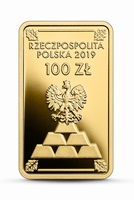
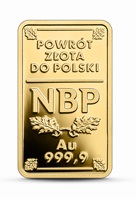
Nominał: 100 zł … Metal: Au 999,9/1000; Stempel: lustrzany;
Wymiary: 23,43 mm × 13,97 mm; Masa: 8,0 g; Brzeg (bok): gładki;
Nakład: do 2019 szt. ; Projektant: Urszula Walerzak; Emitent: NBP;
Na zlecenie NBP monety wyprodukowała Mennica Polska S.A.
Narodowy Bank Polski posiada obecnie 228,6 tony złota, z czego 105 ton jest składowane w skarbcach NBP. W latach 2018–2019 rezerwy złota NBP zostały zwiększone o 125,7 tony (122%), przy czym w 2018 roku NBP zakupił 25,7 tony, natomiast w 2019 roku kolejne 100 ton. W efekcie zakupów zrealizowanych w ostatnich dwóch latach NBP przesunął się w rankingu wielkości zasobu złota z 34. na 22. pozycję wśród banków centralnych na świecie i z 15. na 11. w Europie, wyprzedzając wszystkie kraje regionu. Równocześnie udział złota dewizowego w oficjalnych aktywach rezerwowych wzrósł do 9,1% (wobec 3,8% na koniec 2017 roku). Strategiczna decyzja o zakupie złota wynikała między innymi z dobrej sytuacji gospodarczej oraz sukcesywnego wzrostu aktywów rezerwowych. Złoto jest postrzegane jako strategiczny składnik rezerw dewizowych także ze względu na brak ryzyka kredytowego rozumianego jako możliwość niewywiązania się emitenta z zobowiązań, brak bezpośrednich powiązań z polityką gospodarczą jakiegokolwiek kraju, a także cechy fizyczne – trwałość i właściwie niezniszczalność.
Znaczące zwiększenie zasobu posiadanego złota stanowiło jedną z przesłanek podjęcia przez Zarząd NBP decyzji o dywersyfikacji miejsc przechowywania kruszcu, tak aby mniej więcej połowa rezerw złota, tj. 100 ton, znajdowała się w skarbcach NBP. W ten sposób postępują też inne banki centralne. W symbolicznym znaczeniu możemy uznać, że historia zatoczyła koło i – podobnie jak w II RP – w skarbcach banku centralnego znów znajduje się złoto. Fakt obecności znaczącej części rezerw złota na terenie Polski, w skarbcach NBP, podkreślamy emisją wyjątkowej monety w kształcie sztabki. Ta niezwykła moneta jest także naszym hołdem złożonym pracownikom przedwojennego Banku Polskiego SA, którzy z narażeniem życia i wielkim poświęceniem uchronili ówczesne zasoby złota przed przejęciem przez okupantów. Informacja: Adam Glapiński Prezes Narodowego Banku Polskiego.

The Return of Gold to Poland
www.nbp.pl
On 18 December 2019, Narodowy Bank Polski is putting into circulation a gold coin Return of Gold to Poland with a face value of 100 złoty. All Polish collector coins feature: face value, the image of the Eagle established as the state emblem of the Republic of Poland, inscription: Rzeczpospolita Polska, year of issue. Issuing collector coins is an occasion to commemorate important historic figures and anniversaries, as well as to develop the interest of the public in Polish culture, science, and tradition.


Face value: 100 zł … Metal: Au 999.9/1000; Finish: proof;
Dimensions: 23.43 mm x 13.97 mm; Weight: 8.0 g; Edge (side): plain;
Mintage: up to 2,019 pcs; Designer: Urszula Walerzak; Issuer: NBP;
The coins, commissioned by NBP, were struck by Mennica Polska S.A.
Narodowy Bank Polski presently holds 228.6 tons of gold, of which 105 tons is kept in NBP vaults. In 2018–2019 NBP gold reserves increased by 125.7 tons (122%), with the purchases in 2018 amounting to 25.7 tons and another 100 tons in 2019. As a consequence of the purchases carried out in the last two years, NBP has moved up in the ranking of gold holdings from 34th to 22nd place among central banks all over the world and from 15th to 11th place in Europe, ahead of all the countries of the region. At the same time, the share of monetary gold in official reserve assets has increased to 9.1% (against 3.8% at the end of 2017). The strategic decision to purchase gold was, among others, a result of the good economic situation and the steady increase in reserve assets. Gold is perceived as a strategic component of foreign exchange reserves, partly because it is free from loan risk defined as the possibility of issuer default, because of its decoupling from the economic policy of any single country, as well as its physical properties, such as durability and virtual indestructibility.
The significant increase in the holdings of gold was one of the reasons why the Management Board of NBP decided to have it stored in more numerous locations, with the goal of approximately half of the gold reserves, i.e. 100 tons, being stored in NBP vaults. This is the way that other central banks proceed as well. In a symbolic sense, history may be considered to have come full circle, with Polish central bank vaults holding gold as they did in the Second Polish Republic. The presence of a significant share of Polish gold reserves on the territory of Poland in NBP vaults has been highlighted by the issue of a special coin in the form of a gold bar. This exceptional coin is also our homage paid to the workers of the pre-war Bank Polski SA (Bank of Poland) who, putting their lives at risk, persevered in preventing the gold holdings from being taken over by the German occupiers. Info: Adam Glapiński, President of Narodowy Bank Polski.


Newfoundland’s Fishing Industry
www.canadapost.ca https://postagestampguide.com
Newfoundland’s most famous industry to develop shortly after Cabot’s voyage of discovery in 1497. Because the island lies in close proximity to the Grand Banks, one of the world’s richest fishing grounds, fishermen from France, England, Spain, and Portugal came to the New World to tap the sea’s great resources, especially its cod.
After Newfoundland fell to the British the long process of colonization and development began. Early charters granted to English merchants forbade settlements onshore, but English fishermen and adventurers eventually colonized the island. It was English fishermen who also introduced a fishing method that is still in use today. They engaged in “dry fishing” a process of from five to six weeks in duration whereby fish were salted on board ship, then dried on the island. Early in the 19th century, inshore fisheries started to outstrip the Banks, and the economic base of island life began to broaden. Today probably one-third of the island’s population is directly or indirectly dependent on the fisheries, of which cod remains the most famous. (51-III-20)
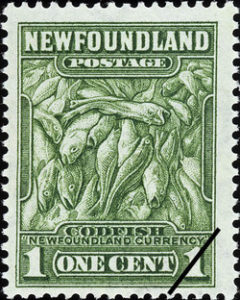
Codfish, “Newfoundland Currency“… Date of Issue: January 1, 1932; Denomination: 1¢; Perforation or Dimension: 13, 13.5; Printer: Perkins, Bacon & Company.; Postal Administration: Newfoundland. Based on a photograph by Robert Edward Holloway. Engraved by Alfred J. Downey.
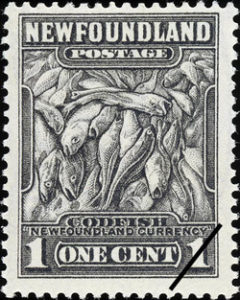
Codfish, “Newfoundland Currency“… Date of Issue: January 1, 1932; Denomination: 1¢; Perforation or Dimension: 13.5, 14; Printer: Perkins, Bacon & Company.; Postal Administration: Newfoundland. Based on a photograph by Robert Edward Holloway. Engraved by Alfred J. Downey.
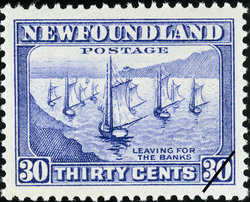
Leaving for the Banks … Date of Issue: January 1, 1932; Denomination: 30¢; Perforation or Dimension: 13.5; Printer: Perkins, Bacon & Company.; Postal Administration: Newfoundland.
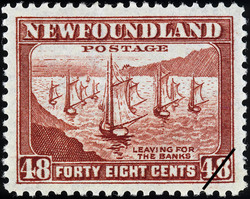
Leaving for the Banks … Date of Issue: January 1, 1943; Denomination: 48¢; Perforation or Dimension: 12.5; Printer: Waterlow & Sons; Postal Administration: Newfoundland. Based on a die by Perkins Bacon Limited.

From Far and Wide 2020:
Booklet of 10 PermanentTM domestic rate stamps
www.canadapost.ca
Get a traveller’s view of some of Canada’s most spectacular scenery with this booklet of 10 PermanentTM domestic-rate stamps, part of the third issue in our multi-year From Far and Wide series. This booklet contains five pairs of stamps, each featuring a photograph capturing a quintessentially Canadian location. See the methane bubbles of Alberta’s Abraham Lake, Saskatchewan’s Athabasca Sand Dunes Provincial Park, Yukon’s Herschel Island-Qikiqtaruk Territorial Park, the fishing village of French River in Prince Edward Island and Quebec’s Îles de la Madeleine.
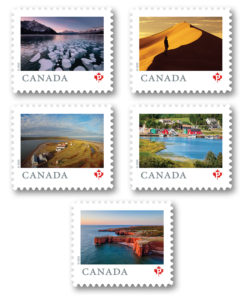
Stamp Value: PermanentTM (domestic rate); Dimensions: 24 mm x 20 mm;
Quantity Produced: Continuous printing; Stamp Designer: Stéphane Huot;
Issue Date: January 13, 2020.
From Far and Wide 2020: Booklet of 6 (Oversized) … Share the views that draw thousands to New Brunswick every year with this booklet of six oversized-rate stamps featuring Grand Manan Island’s historic Swallowtail Lighthouse. Oversized-rate stamps are required for larger documents and unusually shaped envelopes weighing up to 100 grams. This is one of nine definitive stamps in the third issue of From Far and Wide, a multi-year series featuring photos of Canada’s most beautiful landscapes. The first lighthouse to be built on Grand Manan Island in the Bay of Fundy, Swallowtail Lighthouse started service in 1860, its construction spurred by the shipwreck of the Lord Ashburton and the loss of 21 crew members. Swallowtail is perched on a high rugged peninsula that offers magnificent views and opportunities for seal, whale and seabird watching.
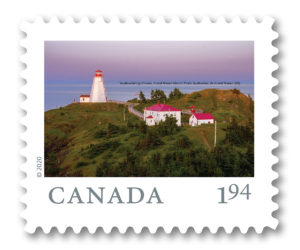
Stamp Value: $1.94 (oversized rate) ; Dimensions: 24 mm x 20 mm;
Quantity Produced: Continuous printing; Stamp Designer: Stéphane Huot;
Issue Date: January 13, 2020.
From Far and Wide 2020: Booklet of 6 stamps (USA) … Share the splendour of British Columbia’s Kootenay National Park, on the occasion of its 100th anniversary, with this booklet of six U.S. rate stamps. This is one of nine definitive stamps in the third issue of From Far and Wide, a multi-year series featuring photos of Canada’s most beautiful landscapes. Kootenay National Park is one of seven national and provincial parks that make up the Canadian Rocky Mountain Parks World Heritage Site. Spanning more than 1,400 km2, Kootenay is home to the Radium Hot Springs and draws hundreds of thousands of visitors every year.
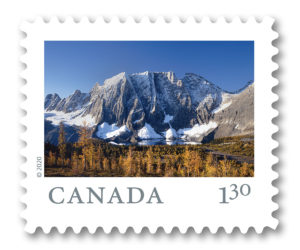
Stamp Value: $1.30 (U.S. rate) ; Dimensions: 24 mm x 20 mm;
Quantity Produced: Continuous printing;
Stamp Designer: Stéphane Huot; Issue Date: January 13, 2020.
From Far and Wide 2020: Booklet of 6 (International) … Capture the coastal views of Cape Breton Island’s Cabot Trail with this booklet of six international-rate stamps. This is one of nine definitive stamps in the third issue of From Far and Wide, a multi-year series featuring photos of Canada’s most beautiful landscapes captured by Canadian photographers. The Cabot Trail is a highway and scenic roadway in Nova Scotia’s Victoria County. Almost 300 km in length, it completes a loop around the northern tip of the island, following the rugged coastline and passing through Cape Breton Highlands National Park.
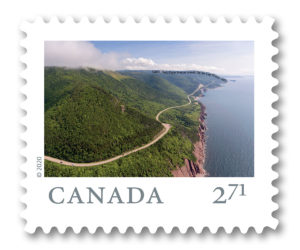
Stamp Value: $2.71 (international rate) ; Dimensions: 24 mm x 20 mm;
Quantity Produced: Continuous printing;
Stamp Designer: Stéphane Huot; Issue Date: January 13, 2020


Pure Silver Coin –
Great Seal of the Province of Canada (1841-1867)
www.canadapost.ca www.mint.ca
The design for this coin comes from an important moment in Canada’s past. The official seal it is based on was created when Britain’s two major Canadian colonies were brought together under a single government for the first time. The images in the design-build on the separate seals of Upper Canada (now Ontario) and Lower Canada (now Quebec) and use popular Victorian imagery—all showcased in stunning detail on a large-format fine silver coin. Before 1841, Upper and Lower Canada each had their own seals. The Great Seal of the Province of Canada placed these seals side-by-side, held up by two allegorical figures with their arms around each other’s shoulders. Over the top of the entire scene is the Royal Arms of Queen Victoria, held by the lion representing England and the unicorn representing Scotland. Every element in this detailed design is symbolic. Here are some of the important symbols: Lower Canada seal (engraved by Thomas Major in 1793): A graceful oak tree on the bank of a river overlooking several ships at anchor, with a typical Quebecois town featuring a church steeple in the background.
Upper Canada seal (from when the province was established in 1792): A peace-pipe or calumet crossed with a sword and an anchor and bound by an olive crown. The Union Jack is visible in the upper right-hand corner and two cornucopias decorate the bottom. Topping the design, to the left of the Union Jack, is the Royal Crown. The royal arms of Queen Victoria (1837): Victoria’s shield, held up by the lion (England) and the unicorn (Scotland). Two allegorical figures: A common practice during this era was to embody political entities like countries or provinces as a Grecian-style female figure. In this image, two graceful ladies embrace each other with one hand while holding up the seals of Upper and Lower Canada with the other. Floral ornamentations: The seal is decorated throughout with the Scottish thistle, English rose, and Irish shamrock.
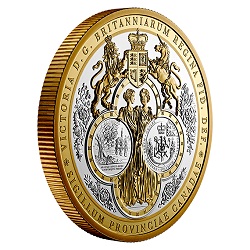
Design: Your coin features the Great Seal of the Province of Canada from 1841, redrawn for use on a Royal Canadian Mint 76.25-millimetre, 10 oz. pure silver coin. The image features all of the elements of the original seal, including the seals of the colonies of Upper and Lower Canada held side-by-side by two allegorical female figures representing the united colonies. The coat of arms of Queen Victoria sits at the top of the image, which also features engravings framing the images and decorative floral engravings. The outer rim includes the Latin text from the original seal: “VICTORIA D.G. BRITANNIARUM REGINA FID. DEF.” and “SIGILLUM PROVINCIAE CANADAE.” The obverse features the effigy of Her Majesty Queen Elizabeth II by Susanna Blunt.
Did you know… The 1840-41 Act of Union united the colonies of Upper Canada (“Canada West” under the new Act, now Ontario) and Lower Canada (“Canada East,” now Quebec) into a single colony with a shared government and economy. It was Canada’s first move toward responsible government and, according to the Canadian Encyclopaedia, was a “26-year experiment in Anglophone-Francophone political cooperation.” There are two stone carvings of the Great Seal of the Province of Canada at the Parliament Buildings. One is above the doorway entrance to the East Block and believed to belong to the original buildings. The other is in the Hall of Honour of the Centre Block, carved in 1953 by Anthony Borysink, William F.K. Oosterhoff, and Wilfrid Rossignol. Packaging: Your coin is encapsulated and presented in a Royal Canadian Mint-branded clamshell with a black beauty box.

2020 … $5 Pure Silver Coin – W Mint Mark
www.canadapost.ca www.mint.ca
This coin’s design is based on the iconic Maple Leaf bullion coins the Mint has produced since it introduced its first gold bullion coin in 1979. The Silver Maple Leaf bullion coin was introduced in 1988. It immediately set a new standard as the world’s first 99.99% pure silver bullion coin. It bears the same reverse design as the Gold Maple Leaf—a highly recognizable image created by Master Engraver Walter Ott. Several elements make this collectible unique. First, it celebrates the global renown of our Maple Leaf bullion coins, which continually set the standard for purity and security. Second, unlike any of our other numismatic or bullion coins, this is the first time a pure silver coin was produced at our facility in Winnipeg, Manitoba. It carries a “W” mint mark on its reverse to highlight that the coin was struck at our Winnipeg location. And finally, it features a unique burnished finish, giving it a ‘matte’ look, making this coin stand out from our other numismatic coins. The maple leaf celebrates our great nation in all its beauty and diversity; this coin is a great way to begin a collection, or a storied addition to any collection featuring Canadian, historical, or nature-themed coins.
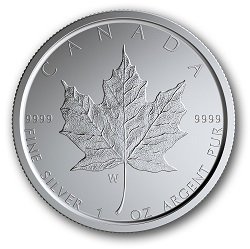
Face value: 5 dollars … Composition: 99.99% pure silver;
Mintage: 10,000; Finish: Burnished; Weight: 31.39 g;
Edge: serrated; Certificate: serialized; Diameter: 38 mm;
Artist: Walter Ott; Susanna Blunt (obverse).
Design: The reverse design for this coin reproduces Master Engraver Walter Ott’s maple leaf from the Mint’s original 1979 bullion coin. This design remains in use on all Royal Canadian Mint bullion coins to this day. The reverse also features a “W” mint mark to the left of the leaf stem, indicating that this numismatic coin was struck at our Winnipeg facility rather than in Ottawa, where numismatic coins are typically struck. The obverse includes the effigy of Her Majesty Queen Elizabeth II by Susanna Blunt.
Did you know… The Royal Canadian Mint first entered the global bullion coin market in 1979 with its Gold Maple Leaf bullion coin. At the time, the worldwide quality standard was 99.9% purity. Canada’s bullion coins immediately set themselves apart on the world stage for its purity—other metal alloys were absent in our bullion. Four years later, the Mint set a new global standard, a 99.99% pure Gold Maple Leaf bullion coin. To create this coin, a die setter trainer, a Training Coordinator and a Quality Assurance associate from our Ottawa facility travelled to Winnipeg to teach the knowledge and process skills, for achieving the coin’s unique numismatic qualities.

2020 … $50 Pure Silver Coin – Real Shapes: The Common Loon
www.mint.ca
A not-so-common loon…A not-so-common coin! The beloved loonie garnered significant attention when it entered circulation in 1987. It wasn’t Canada’s first circulation 1-dollar coin—that claim to fame belongs to the 1935 Voyageur silver dollar, a non-circulating commemoration of the silver jubilee of King George V —but it marked a major milestone in Canadian currency as the country said goodbye to the one-dollar banknote. For this amazing coin—the first in our series of seven—the famous loon swims outside its circle in a Royal Canadian Mint first!
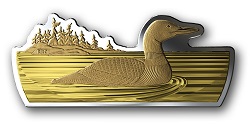
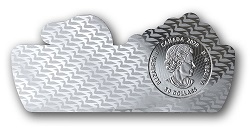
Face value: 50 dollars … Composition: 99.99% Pure Silver;
Mintage: 1200; Weight: 100 g; Diameter: 83.9 mm x 35.4 mm;
Finish: Proof; Artist: Robert-Ralph Carmichael.
Canadian currency icons are shown in a brand new light. This uniquely-shaped coin is the first of the Royal Canadian Mint’s 6-coin series of intricately shaped pure silver coins featuring iconic coin designs transcending their circular boundaries. Accented with 24kt gold plating. Unique packaging highlights the uniqueness and beauty of your coin. Specially shaped capsule showcases the coin silhouette. A low mintage of only 1,200 coins means this collectible is sure to sell out quickly. Each coin in the series is an exquisite gift idea and a great way to spark interest in coin collecting. They are also ideal additions for any collector interested Canadian coinage history or general Canadiana.

2020 … Pure Silver Maple Leaf Fractional Set – O Canada
www.mint.ca
Sing with pride: This year’s five-piece celebration of ‘O Canada’ gets a sparkling colour boost. It is our song, the one that represents every Canadian from coast to coast and across “the True North strong and free.
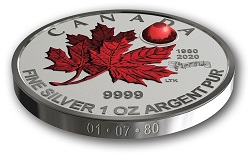
All five coins share the same double-dated design. A red Swarovski® element adds extra sparkle to the 1 oz. coin design which also showcases a deep red (the colour of Canada). But it is the addition of an engraved musical staff — with the famous opening notes of O Canada — that ensures our anthem will always have a place in your heart and your collection. Celebrate O Canada’s 40-year milestone. Canada’s pride for our national anthem shines in this five-piece fractional set (1 oz., ½ oz., ¼ oz., 1/10 oz. and 1/20 oz.), which commemorates the 40th anniversary of the National Anthem Act — an act that made O Canada the official national anthem of Canada. Reverse proof finish. The coin’s reverse proof finish ensures all eyes are on the engraved relief.

Composition: 99.99% Pure Silver; Mintage: 3,000;
Weight: $5 coin: 31.39 g; $4 coin: 15.87 g;
$3 coin: 7.96 g; $2 coin: 3.23 g; $1 coin: 1.63 g;
Diameter: $5 coin: 38 mm; $4 coin: 34 mm;
$3 coin: 27 mm; $2 coin: 20 mm; $1 coin: 16 mm;
Finish: Reverse Proof with colour; Artist: Lisa Thompson Khan.


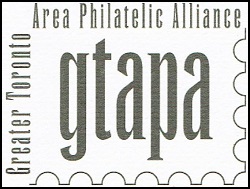
www.gtapa.org
The GTAPA is committed to promote and
stimulate the art of philately to all ages for fun,
culture, education, and friendship.




